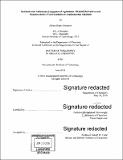| dc.contributor.advisor | Mohammad Movassaghi. | en_US |
| dc.contributor.author | Antropow, Alyssa Hope | en_US |
| dc.contributor.other | Massachusetts Institute of Technology. Department of Chemistry. | en_US |
| dc.date.accessioned | 2018-09-28T20:57:10Z | |
| dc.date.available | 2018-09-28T20:57:10Z | |
| dc.date.copyright | 2018 | en_US |
| dc.date.issued | 2018 | en_US |
| dc.identifier.uri | http://hdl.handle.net/1721.1/118214 | |
| dc.description | Thesis: Ph. D. in Organic Chemistry, Massachusetts Institute of Technology, Department of Chemistry, 2018. | en_US |
| dc.description | Cataloged from PDF version of thesis. Vita. | en_US |
| dc.description | Includes bibliographical references. | en_US |
| dc.description.abstract | I. Synthesis and Evaluation of Agelastatin Derivatives as Potent Modulators for Cancer Invasion and Metastasis The synthesis of new agelastatin alkaloid derivatives and their anticancer evaluation in the context of the breast cancer microenvironment is described. A variety of Ni -alkyl and C5-ether agelastatin derivatives were accessed via application of our strategy for convergent imidazolone synthesis. We have discovered that agelastatin alkaloids are potent modulators for cancer invasion and metastasis at non-cytotoxic doses. We discuss the increased potency of (-)-agelastatin E as compared to (-)-agelastatin A in this capacity, in addition to identification of new agelastatin derivatives with activity that is statistically equivalent to (-)-agelastatin E. II. Enantioselective Synthesis of (-)-Vallesine: Late-stage C17-Oxidation via Complex Indole Boronation The first enantioselective total synthesis of (-)-vallesine via a strategy that features a late-stage regioselective C17-oxidation followed by a highly stereoselective transannular cyclization is described. The versatility of this approach is highlighted by divergent synthesis of the archetypal alkaloid of this family, (+)-aspidospermidine, and an A-ring oxygenated derivative (+)- deacetylaspidospermine, the precursor to (-)-vallesine, from a common intermediate. III. Enantioselective Total Synthesis of (-)-Jerantinine A from (-)-Melodinine P via Bio-Inspired A-Ring Oxidation The first enantioselective synthesis of (-)-melodinine P and its direct conversion to related alkaloid (-)-jerantinine A is described. A key para-aza-quinone methide pentacyclic intermediate enables A-ring to C-ring oxidation state transfer. Our synthesis is streamlined through the development of two multi-step single-pot procedures which proceed with high efficiency. We further demonstrate the utility ofpara-aza-quinone methide intermediates in our strategy for CI6-methoxylation which provides entry to the (-)-jerantinine alkaloid family. | en_US |
| dc.description.statementofresponsibility | by Alyssa Hope Antropow. | en_US |
| dc.format.extent | 231 pages | en_US |
| dc.language.iso | eng | en_US |
| dc.publisher | Massachusetts Institute of Technology | en_US |
| dc.rights | MIT theses are protected by copyright. They may be viewed, downloaded, or printed from this source but further reproduction or distribution in any format is prohibited without written permission. | en_US |
| dc.rights.uri | http://dspace.mit.edu/handle/1721.1/7582 | en_US |
| dc.subject | Chemistry. | en_US |
| dc.title | Synthesis and anticancer evaluation of agelastatin alkaloid derivatives and enantioselective total synthesis of aspidosperma alkaloids | en_US |
| dc.type | Thesis | en_US |
| dc.description.degree | Ph. D. in Organic Chemistry | en_US |
| dc.contributor.department | Massachusetts Institute of Technology. Department of Chemistry | |
| dc.identifier.oclc | 1052565655 | en_US |
